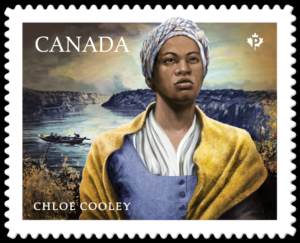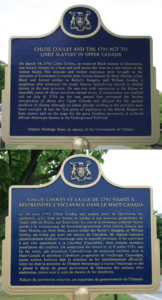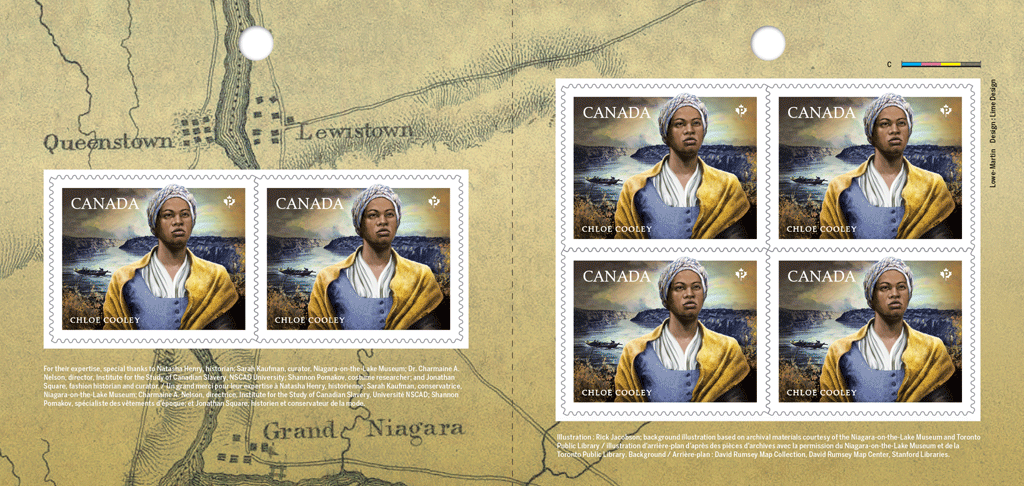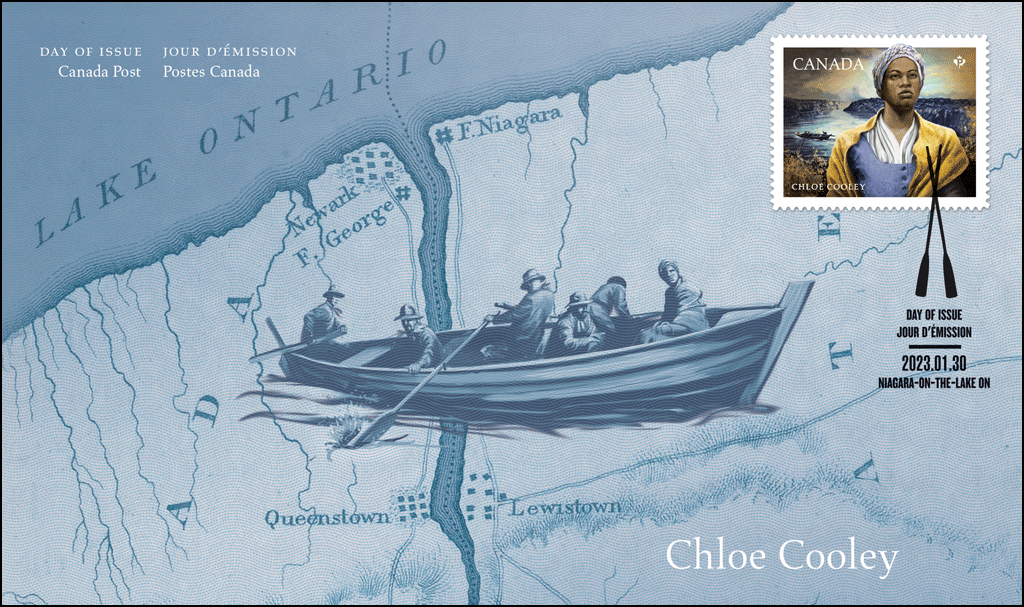Hours after we posted Danforth’s story, Canada Post issued a press release confirming his story.]
By Danforth Guy
An enslaved woman who became a symbol of resistance to slavery and a catalyst to the abolition movement will be featured on Canada Post’s 2023 Black History stamp, to be  issued January 30. Chloe Cooley’s violent protest to being sold by her Ontario owner to one in New York in 1793 led directly to a law restricting slavery in the province known as Upper Canada, at the time.
issued January 30. Chloe Cooley’s violent protest to being sold by her Ontario owner to one in New York in 1793 led directly to a law restricting slavery in the province known as Upper Canada, at the time.
Cooley was forced into a boat in Queenston, Ontario, screaming and flailing. She was then bound and gagged, and could not escape her captors, who took her across the Niagara River to owners in New York.
The scene was witnessed on the Ontario shore by a free Black veteran of the American Revolution, Peter Martin, and by a white employee of Cooley’s Loyalist slave owner. They reported the disturbing scene to Lt.-Governor John Simcoe.
The law that resulted was a compromise, as many in the government were slave-owners, themselves. The 1793 Act did not free a single slave, but it did prohibit the importation of slaves, and freed the children of slaves at age 25. This eventually created a safe haven that made southern Ontario the ultimate destination on the Underground Railroad.
The first day issue location has not been announced, but it’s a good guess the postmark will read “Queenston, ON.” The self-adhesive stamp will be issued in a booklet of six at the first-class domestic rate (92¢), using the ‘P’ indicia.
Chloe Cooley was named a National Historic Person in 2022, and will eventually see a federal plaque in her honour. Meantime, the Ontario Heritage Trust erected this plaque [shown on the left; click to see a much larger version] in 2007 along the Niagara Parkway, near the site of her unwilling removal.
Note: There are no known pictures of Cooley.
[press release] [click on any of the pictures for larger versions]
Black History Month Stamp Honours Chloe Cooley
Although unable to escape her own bondage, Cooley’s resistance helped forge a path to freedom for enslaved people in Upper Canada
NIAGARA-ON-THE-LAKE, ON, Jan. 29, 2023 /CNW/ – Today, Canada Post unveiled a new Black History Month stamp honouring Chloe Cooley, who had a profound impact on  the history of enslavement in Canada. Her act of resistance on the evening of March 14, 1793, ushered in legislation that would lead to the gradual abolition of enslavement in Upper Canada and provide a refuge for freedom-seekers from abroad.
the history of enslavement in Canada. Her act of resistance on the evening of March 14, 1793, ushered in legislation that would lead to the gradual abolition of enslavement in Upper Canada and provide a refuge for freedom-seekers from abroad.
Cooley was a young, Black enslaved woman who lived in Queenston, Upper Canada, in the late 18th century. Although enslavement in Upper Canada was on the rise at the time, attitudes toward it were shifting and the abolitionist movement was gaining momentum.
Rumours were growing that enslavement could soon be banned. Fear of losing their investments prompted some enslavers to sell what was legally considered their property. Among them were Sergeant Adam Vrooman, who enslaved Chloe Cooley.
On that chilly March evening, Vrooman abducted Cooley. He violently bound her and, with the assistance of two other men, dragged her to the shores of the Niagara River. But Cooley was defiant. [The booklet pane is shown below.]
She had been known to bravely challenge her enslavement in the ways that she could, such as leaving Vrooman’s property without permission and refusing to do some tasks. So, when her enslaver abducted her, she fought back hard, screaming and yelling for help as she struggled to get free. Her protests were so loud that they drew the attention of those nearby.
Ultimately, however, Cooley was overpowered and taken across the river to New York State, where she was sold.
Although history doesn’t tell us what happened to Cooley after that night, witnesses recounted what they saw to Lieutenant-Governor John Graves Simcoe, an avowed abolitionist. He was able to use their testimony to introduce new legislation. [The Official First Day Cover is shown below.]
On July 9, 1793, what became known as the Act to Limit Slavery in Upper Canada was passed.
Cooley herself did not benefit from the legislation, but it opened a pathway to freedom for others, as it set the stage for the gradual ending of enslavement in Upper Canada. It also created a legal refuge for those fleeing enslavement in other countries – helping to pave the way for at least 30,000 freedom-seeking Black Americans to make the dangerous journey north to Canada over the decades to come.
In 1833, enslavement was officially abolished throughout the British Empire, and the last remaining enslaved persons in Upper Canadawould finally be freed.
About the stamp
 The Chloe Cooley stamp was designed by Lime Design and features the illustrative work of Rick Jacobsen. With no photographs of Chloe Cooley in existence, the illustration was painstakingly created through extensive consultation with experts in local and regional history, Black history and period fashion, as well as through the use of archival maps, paintings, illustrations and other documents. Printed by Lowe-Martin, the issue includes a booklet of six PermanentTM domestic rate stamps and an Official First Day Cover. The cancel site is Niagara-on-the-Lake, Ontario, which includes Queenston.
The Chloe Cooley stamp was designed by Lime Design and features the illustrative work of Rick Jacobsen. With no photographs of Chloe Cooley in existence, the illustration was painstakingly created through extensive consultation with experts in local and regional history, Black history and period fashion, as well as through the use of archival maps, paintings, illustrations and other documents. Printed by Lowe-Martin, the issue includes a booklet of six PermanentTM domestic rate stamps and an Official First Day Cover. The cancel site is Niagara-on-the-Lake, Ontario, which includes Queenston.
The stamp and collectibles are available at canadapost.ca and postal outlets across Canada.
[en Francais pour les médias d’information]
Un Timbre Du Mois De L’histoire Des Noirs En Hommage À Chloe Cooley
Bien qu’incapable d’échapper à son esclavage, Chloe Cooley a contribué par sa résistance à la mise en liberté des personnes asservies dans le Haut-Canada.
NIAGARA-ON-THE-LAKE, ON, le 29 janv. 2023 /CNW/ – Aujourd’hui, Postes Canada a dévoilé un nouveau timbre du Mois de l’histoire des Noirs en l’honneur de Chloe Cooley,  qui a eu une grande incidence sur l’histoire de l’esclavage au Canada. Sa résistance le soir du 14 mars 1793 a contribué à l’adoption d’une loi qui allait mener à l’abolition graduelle de l’esclavage dans le Haut-Canada et offrir un refuge aux esclaves d’autres pays.
qui a eu une grande incidence sur l’histoire de l’esclavage au Canada. Sa résistance le soir du 14 mars 1793 a contribué à l’adoption d’une loi qui allait mener à l’abolition graduelle de l’esclavage dans le Haut-Canada et offrir un refuge aux esclaves d’autres pays.
Chloe Cooley était une jeune femme noire asservie comme domestique à Queenston, dans le Haut-Canada, à la fin du XVIIIe siècle. Bien que l’esclavage dans le Haut-Canada gagnait en popularité à l’époque, l’attitude à l’égard de la pratique changeait et le mouvement abolitionniste prenait de l’ampleur.
Alors que commençaient à planer des rumeurs d’abolition, des maîtres craignaient de perdre ce qui était légalement considéré comme leur propriété. Le sergent Adam Vrooman, le maître de Chloe Cooley, était de ce nombre.
Un soir frisquet de mars, Adam Vrooman a enlevé la jeune femme, l’a violemment ligotée et, avec l’aide de deux hommes, l’a traînée sur les rives de la rivière Niagara. Mais Chloe Cooley s’est débattue.
Elle avait la réputation de lutter courageusement contre son esclavage de toutes les manières possibles, notamment en quittant la propriété d’Adam Vrooman sans permission et en refusant d’accomplir certaines tâches. Alors, quand son maître l’a enlevée, elle s’est débattue et a crié à l’aide pour tenter de se libérer. Ses protestations bruyantes ont été entendues dans les environs.
Malgré sa résistance, Chloe Cooley a été maîtrisée et transportée de force par bateau de l’autre côté de la rivière, dans l’État de New York, où elle a été vendue.
Bien qu’on ignore ce qui est arrivé à la jeune femme après cette soirée, des témoins ont raconté l’événement au lieutenant-gouverneur John Graves Simcoe, un fervent abolitionniste. Ce dernier s’est servi de ces témoignages pour déposer un projet de loi.
Le 9 juillet 1793, la mesure législative qui est devenue la loi visant à restreindre l’esclavage dans le Haut-Canada a été adoptée.
Si Chloe Cooley n’en a pas profité, la loi a ouvert la voie à la liberté pour d’autres en menant à l’abolition graduelle de l’esclavage dans le Haut-Canada. Elle a également créé un refuge légal pour les personnes qui fuyaient l’esclavage dans d’autres pays et a aidé au moins 30 000 Américains noirs en quête de liberté à faire le périlleux voyage vers le Canada au cours des décennies qui ont suivi.
En 1833, l’esclavage a été aboli officiellement à l’échelle de l’Empire britannique, et les derniers esclaves du Haut-Canada ont finalement été libérés.
À propos du timbre
Le timbre consacré à Chloe Cooley a été conçu par Lime Design et est orné d’une illustration de Rick Jacobsen. En l’absence de photos de la jeune femme, les images ont été créées avec soin à la suite de consultations approfondies avec des experts en histoire locale et régionale, en histoire des Noirs et en mode d’époque, ainsi qu’à l’aide de cartes historiques, de peintures, d’illustrations et d’autres documents d’archives. Imprimée par Lowe-Martin, l’émission comprend un carnet de six timbres PermanentsMC au tarif du régime intérieur et un pli Premier Jour officiel oblitéré à Niagara-on-the-Lake, en Ontario, où se trouve Queenston.
La vignette et les articles de collection sont en vente sur postescanada.ca et dans les comptoirs postaux partout au pays.



